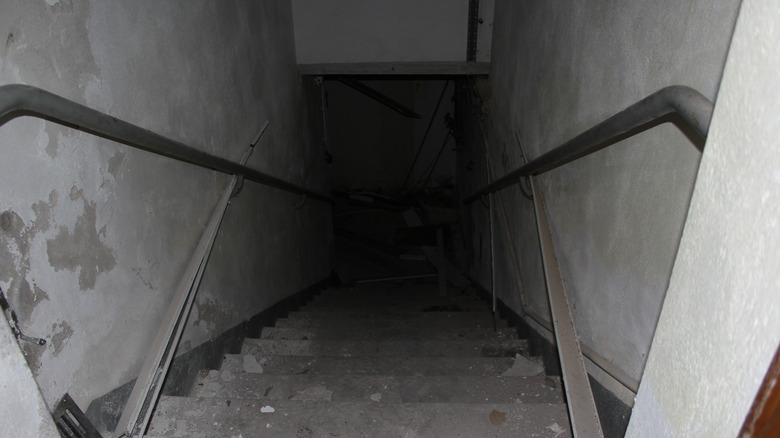Who Is Elisabeth Fritzl And Where Is She Today?
Even for those familiar with true crime and the full range of humanity's abyssal depravities, some stories defy belief and reason. Such is the case with "the girl in the basement," Elisabeth Fritzl, who suffered beyond the capability of most of us to comprehend.
The short of the story is this: On April 26, 2008, Elisabeth Fritzl saw the light of day for the first time in 24 years. As sites like All That's Interesting recount, her 19-year-old daughter Kerstin had gotten sick and needed medical attention. Her father, Josef Fritzl, reluctantly consented and released Kerstin from the basement of their family house at Ybbsstrasse 40 in Amstetten, Austria. Sometime later he set Elisabeth free, too.
But to the rest of the world, Elisabeth had vanished back in 1984 at the age of 18. Her father said she'd run off and joined a cult. In reality, he'd imprisoned her in the dirt-walled family basement, where he admitted on the Independent that he'd raped her "at least 3,000 times." Elisabeth bore him seven children. One died shortly after birth, two lived in the basement with their mother (Kerstin and Stefan), and the rest lived above with Josef and his wife, Rosemarie. And yet, no one above apparently knew what was going on below.
At present, Josef is alive and serving out his sentence at a unit for the "criminally insane" at Austria's Krems-Stein prison, The Sun reported. As for Elisabeth, she and her children relocated to a secret Austrian village known only as "Village X."
If you or anyone you know has been a victim of sexual assault, help is available. Visit the Rape, Abuse & Incest National Network website or contact RAINN's National Helpline at 1-800-656-HOPE (4673).
Starting a new life in a countryside village
Of out a very non-voyeuristic respect for the survivors of Josef Fritzl's inhuman actions, this article makes no attempts to uncover additional information about Elisabeth Fritzl's current goings-on beyond what she's chosen to willingly discuss with media outlets, and beyond what authorities have chosen to disclose.
According to a 2009 Mirror report, Elisabeth and her six surviving children moved to a small Austrian countryside community of about 22,000 within a year or so of finding their freedom. Their house had steel fencing around it, a CCTV-operated gate, cameras on the premises, and trees blocking the windows. The family split its time between home and the hospital, where they underwent therapy and treatment. Locals knew about the family's history, but honored their privacy and let them be. It should be noted, though, that this information dates to when this story first broke.
Ten years later, however, some things remained the same. A 2019 Mirror article describes the family continuing to live together in the same "brightly-painted" two-story house. They kept the doors to their bedrooms permanently open and underwent therapy every week. Security guards patrolled the perimeter of the home, and CCTV could alert police to the property within minutes. Elisabeth, we learn, was given a new name after her trial for her own protection and recovery. As of 2024, her children would range from ages 20 to 34, with Elisabeth herself — imprisoned from ages 18 to 42 — being about 57.
If you or someone you know may be the victim of child abuse, please contact the Childhelp National Child Abuse Hotline at 1-800-4-A-Child (1-800-422-4453) or contact their live chat services.
Finding love and happiness
As All That's Interesting says, Elisabeth Fritzl's children Kerstin and Stefan had the hardest time adjusting to life outside of their basement captivity, as they'd never once left its confines. Elisabeth, by all accounts, had done her best to give them some kind of basic education while imprisoned. But following the family's 2008 release, the Mirror says that Kerstin and Stefan experienced nightmares, panic attacks, and obsessive-compulsive disorder (OCD). Three of the other children, however — Lisa, Monika, and Alexander, who lived above with Josef and Rosemarie — attended regular schools at the time. The youngest, pre-school-age child, Felix, had to wear dark glasses to cope with natural light. All six children suffered immune system problems.
And yet, by 2019 the Mirror described Elisabeth's children doing typical life things like shopping, passing driving tests, and playing PlayStation games. Elisabeth, The U.S. Sun says, wound up falling in love with her bodyguard, Thomas Wagner, in 2019. She was 52 at the time, and he was 29. Wagner moved in with the family, and the two are still happily together. Speaking of their relationship and Elisabeth's life at present in general, a psychiatrist who cared for Elisabeth said, "This is vivid proof of love being the strongest force in the world. With the approval of her doctors she has ceased psychiatric therapies while she gets on with her life — learning to drive, helping her children with their homework, making friends with people in her locality."
If you or someone you know needs help with mental health, please contact the Crisis Text Line by texting HOME to 741741, call the National Alliance on Mental Illness helpline at 1-800-950-NAMI (6264), or visit the National Institute of Mental Health website.


